Are you tired of relying on takeout for your favorite chicken and shrimp dishes? It can be expensive and often lacks the personal touch that makes a meal truly special. Combining chicken and shrimp in various recipes allows you to create delicious, restaurant-quality meals in the comfort of your home.
Imagine being able to whip up a flavorful stir-fry or a hearty one-pot meal that’s not only healthier but also more cost-effective than ordering takeout. With simple pantry ingredients, you can transform basic proteins into culinary masterpieces.
Exploring international flavors like Cajun, Thai, or Mediterranean cuisine can add a new dimension to your cooking. By mastering these versatile recipes, you’ll not only expand your cooking repertoire but also impress your family and friends with minimal effort.
Table of Contents
Why Make Chicken and Shrimp Recipes at Home?
By choosing to make chicken and shrimp dishes at home, you’re making a positive impact on your health and wallet. Preparing meals at home gives you control over the ingredients and portion sizes, which is crucial for maintaining a healthy diet and managing nutrition. Many people are shifting towards healthier living by making conscious choices about the food they consume.
Health Benefits of Homemade vs. Takeout
Making chicken and shrimp recipes at home allows you to avoid excessive sodium, MSG, and preservatives commonly found in takeout. You can select higher-quality proteins and control portion sizes for better nutrition and diet management. This approach to cooking not only improves the quality of your meals but also contributes to overall healthier eating habits.
As someone who has read extensively on diet and nutrition, it’s clear that homemade meals offer significant health benefits. By choosing organic chicken and sustainably sourced shrimp, you can enhance both the nutrition and flavor of your dishes.
Cost Savings of DIY Recipes
Cooking at home can lead to substantial cost savings. A $20 restaurant dish can often be made at home for less than $8 with the same ingredients. Buying chicken and shrimp in bulk or on sale and freezing portions further increases your savings while maintaining convenience. This approach to meal preparation not only benefits your wallet but also promotes a more sustainable approach to food consumption.
By making these recipes at home, you can also customize spice levels and ingredient substitutions to suit your taste preferences and dietary needs, all while keeping costs in check.
Essential Ingredients for Chicken and Shrimp Dishes
Elevating your chicken and shrimp dishes to restaurant quality requires a thoughtful selection of ingredients. The right combination of pantry staples and fresh ingredients can make all the difference in the flavor and quality of your meals.
Pantry Staples You’ll Need
A well-stocked pantry is essential for creating restaurant-quality chicken and shrimp dishes. Basics like quality olive oil and kosher salt form the foundation of most recipes. For Asian-inspired dishes, keep soy sauce, fish sauce, sesame oil, and rice vinegar on hand. These pantry staples have long shelf lives but deliver authentic flavors. For Cajun and Creole recipes, paprika, cayenne, thyme, oregano, and garlic powder are must-haves to create signature spice blends.
Fresh Ingredients That Make a Difference
Fresh aromatics like garlic, ginger, shallots, and fresh herbs elevate chicken and shrimp dishes from good to exceptional. When selecting shrimp, look for firm texture and mild ocean smell; avoid those with black spots, sliminess, or strong ammonia odors. For chicken, boneless skinless breasts work well for quick-cooking recipes, while thighs provide more flavor and moisture tolerance in longer-cooking dishes. Fresh citrus fruits like lemons and limes are also worth keeping on hand as their juice and zest brighten almost any chicken and shrimp combination.
Quick Cooking Tips for Perfect Chicken and Shrimp
With a few expert tips, you can create mouth-watering chicken and shrimp dishes that rival your favorite takeout. Cooking these proteins to perfection requires understanding their unique cooking times and techniques.
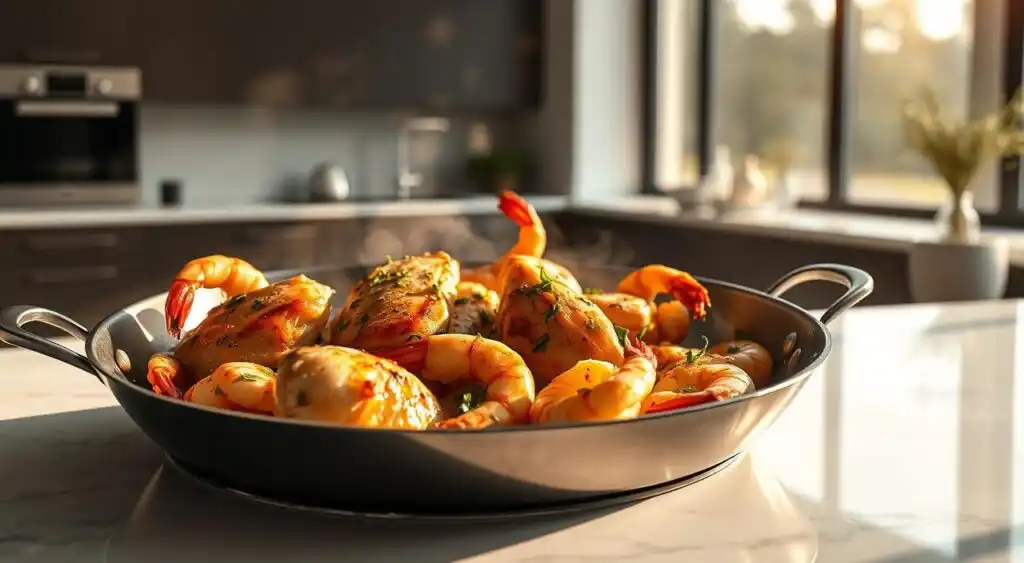
How to Avoid Overcooking Shrimp
Shrimp cook extremely quickly, typically requiring only 2-3 minutes per side. They’re done when they turn pink and opaque with a slight C-shape. To avoid rubbery, overcooked seafood, add shrimp to your skillet in the final few minutes of cooking, especially when combined with chicken.
- Cook shrimp until they turn pink and opaque.
- Avoid overcooking by not exceeding 2-3 minutes per side.
- Add shrimp towards the end of the cooking time when cooking with chicken.
Ensuring Juicy Chicken Every Time
To achieve juicy chicken, it’s crucial to cook it evenly. Pounding chicken breasts to an even thickness or cutting into uniform strips ensures consistent cooking time. Additionally, marinating chicken for 15-30 minutes before cooking can dramatically improve its flavor and tenderness.
- Pound or cut chicken into uniform pieces for even cooking.
- Marinate chicken for 15-30 minutes to enhance flavor and tenderness.
- Use a meat thermometer to ensure chicken is cooked to a safe internal temperature of 165°F.
Garlic Butter Chicken and Shrimp Pasta
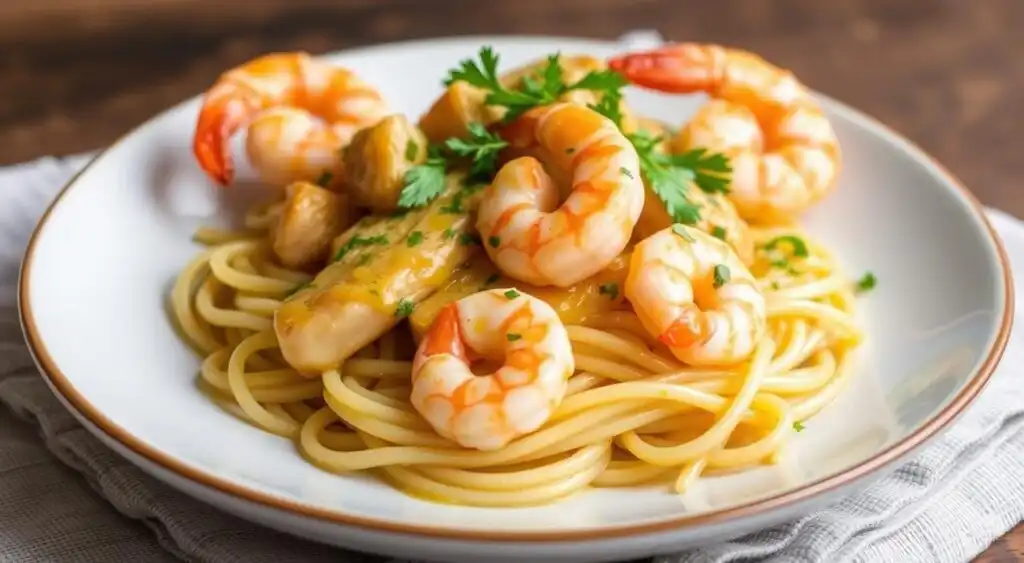
Elevate your weeknight dinner with Garlic Butter Chicken and Shrimp Pasta, a quick and flavorful dish featuring chicken, shrimp, and a decadent garlic butter sauce. This recipe is perfect for those who crave takeout-style meals but prefer to cook at home.
Ingredients and Preparation
To make Garlic Butter Chicken and Shrimp Pasta, you’ll need a combination of pantry staples and fresh ingredients. The key components include 3 ounces (6 tablespoons) of unsalted butter, 1/4 cup of extra-virgin olive oil, 4 cloves of garlic (minced), 1 tablespoon each of coarsely chopped fresh basil and parsley, 1/2 teaspoon of kosher salt, and 1/2 teaspoon of Creole seasoning. Fresh garlic is essential for authentic flavor; you can mince it finely for a subtle presence or roughly chop it for more pronounced garlic bites.
Preparation is straightforward: brown the chicken before adding the shrimp to ensure both proteins are perfectly cooked. Using both butter and olive oil creates a silky sauce with a higher smoke point, preventing the garlic from burning while imparting rich flavor.
Cooking Process and Serving Suggestions
The cooking process involves browning the chicken, cooking the shrimp, and then combining them with garlic butter sauce and al dente pasta. Al dente pasta works best as it continues cooking slightly when tossed with the hot sauce. Linguine and fettuccine hold the sauce well, but angel hair provides a lighter option.
To serve, finish the dish with fresh herbs, a squeeze of lemon juice, and freshly grated Parmesan cheese to elevate the flavors and provide a restaurant-quality presentation. For a lighter version, you can substitute half the butter with additional olive oil and add a splash of chicken broth to maintain sauce consistency.
Cajun Chicken and Shrimp Jambalaya
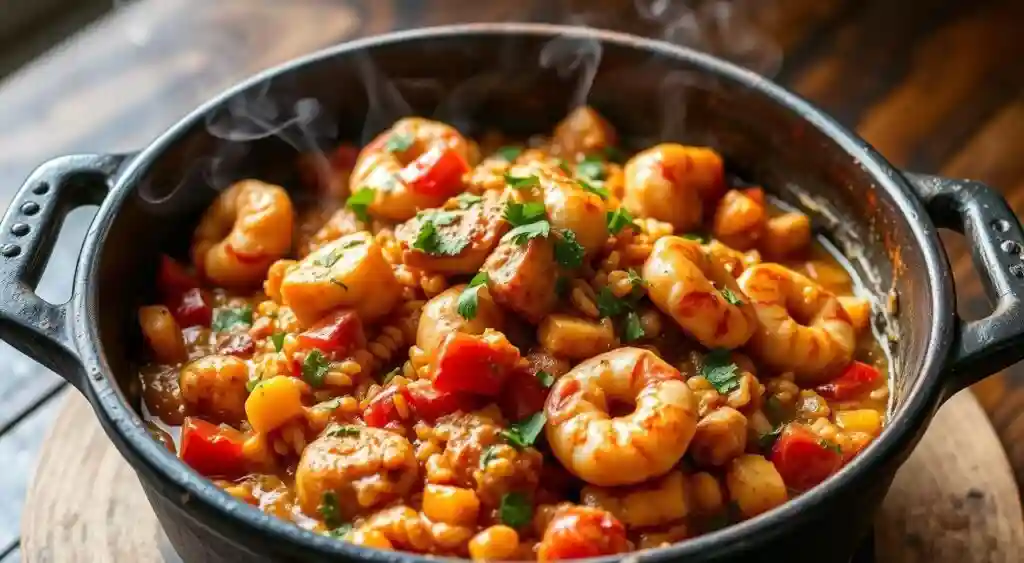
This Cajun Chicken and Shrimp Jambalaya recipe brings the authentic taste of New Orleans to your kitchen. It’s a hearty, one-pot meal that combines chicken and shrimp with rice and a blend of spices and seasoning that will leave you craving more.
Traditional vs. Quick-Cook Methods
Authentic jambalaya builds flavor through a slow-cooking process, allowing the rice to absorb seasoned broth gradually. However, quick-cook methods can also produce delicious results with a bit of compromise on the depth of flavor. The key to both methods is the “holy trinity” of Cajun cooking: onions, bell peppers, and celery, which form the aromatic base of the dish.
While traditional jambalaya uses long-grain white rice, you can opt for cauliflower rice as a low-carb alternative that still absorbs flavors well.
Spice Adjustments for Personal Preference
Cajun seasoning blends vary widely in salt and heat levels. It’s essential to taste before adding the full amount called for, especially when using commercial blends. For those sensitive to spice, you can reduce the spices, such as cayenne pepper, while maintaining other flavors like paprika, thyme, and oregano to preserve the characteristic Cajun flavor profile.
Building a color gradient in your jambalaya, from golden to reddish-brown, indicates the proper development of flavors. Avoid stirring too frequently to allow this caramelization to occur, enhancing the overall taste of your dish.
One-Pot Chicken and Shrimp Gumbo
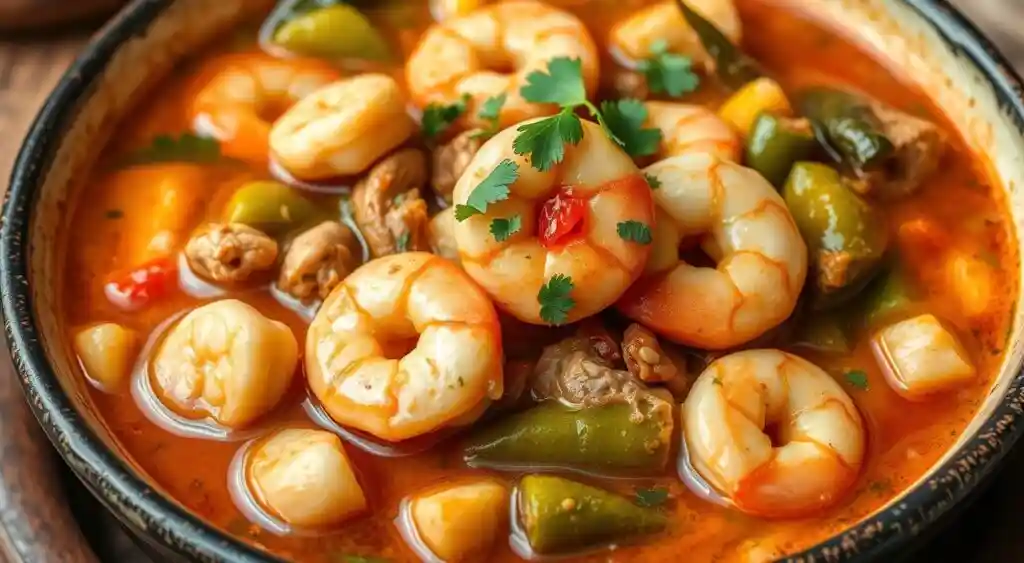
Gumbo, a hearty dish originating from Louisiana, combines chicken and shrimp in a rich, flavorful stew. This one-pot wonder is a staple in many cuisines, offering a comforting meal that’s both nourishing and delicious.
The traditional recipe for gumbo involves making a roux, a mixture of flour and fat, which serves as the base of the stew. However, variations exist, including low-carb versions that skip the roux or use alternative thickening agents.
Making the Perfect Roux
A traditional gumbo roux requires patient stirring of equal parts flour and fat (oil or butter) until it reaches the desired color. The key to a successful roux is constant attention and medium-low heat; rushing this process results in a bitter, burnt flavor.
For those looking for a low-carb alternative, okra’s natural thickening properties can replace flour-based roux or a small amount of file powder (ground sassafras) can be added at the end of cooking.
Slow-Cooked Flavor in Less Time
Traditional gumbos simmer for hours, but you can achieve similar depth by using concentrated flavor boosters like rich homemade stock, browning the chicken well before adding liquid, and incorporating umami-rich ingredients.
Adding shrimp only in the final 5-7 minutes of cooking preserves their tender texture while still allowing them to absorb the gumbo’s complex flavors. Bone-in chicken pieces create more flavorful gumbo, but boneless thighs offer a convenient compromise between flavor and ease.
Thai Coconut Chicken and Shrimp Soup
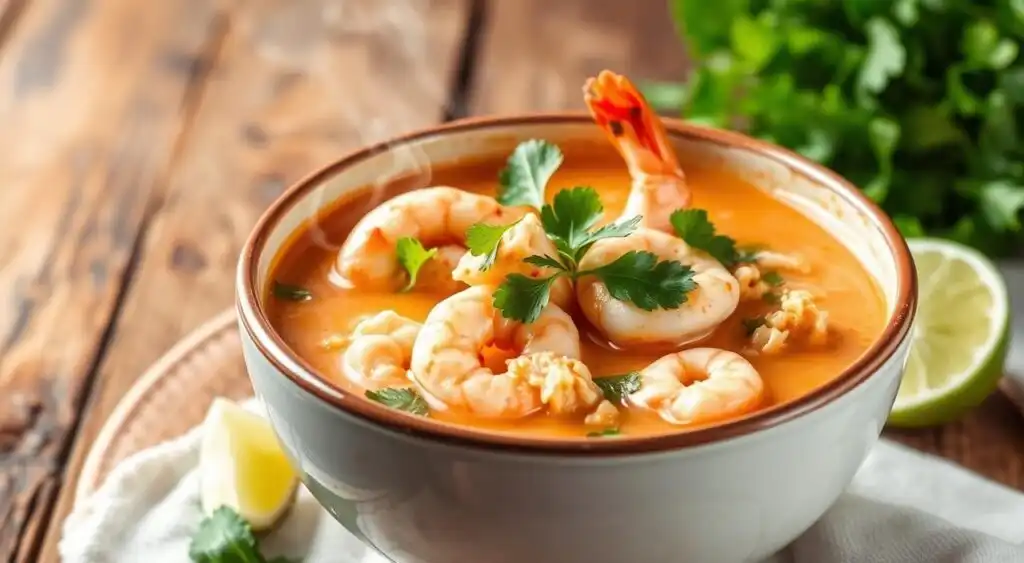
You can easily recreate the authentic taste of Thai Coconut Chicken and Shrimp Soup at home. This dish is renowned for its delicate balance of spicy, sweet, salty, and sour flavors, creating a complex taste experience. The key to its authentic flavor lies in the use of fresh aromatics such as lemongrass, galangal, makrut lime leaves, and Thai chilies.
Authentic Thai Flavors at Home
To achieve an authentic Thai flavor, it’s crucial to use the right ingredients. The soup’s fragrant base is created by combining lemongrass, galangal, and makrut lime leaves. These ingredients give the soup its distinctive flavor profile. Fish sauce is also essential as it adds a depth of umami flavor without making the soup taste fishy.
The order of adding ingredients is important. Chicken should be added early to infuse the broth with its flavor, while shrimp should be added just before serving to prevent overcooking.
Ingredient Substitutions for American Kitchens
While traditional Thai ingredients are preferred, substitutions can be made when they are not available. For example, ginger can be used instead of galangal, and serrano peppers can replace Thai chilies. Regular lime zest can be used as a substitute for makrut lime leaves. These substitutions help in achieving a similar flavor profile in American kitchens.
When serving, garnish with fresh cilantro, lime wedges, and sliced chilies to allow diners to adjust the flavor to their liking, following an authentic Thai dining tradition.
Chicken and Shrimp Fried Rice
Mastering chicken and shrimp fried rice is a game-changer for home cooks looking to elevate their takeout game. This versatile dish combines protein-rich chicken and shrimp with rice, making it a satisfying meal.
The key to a great chicken and shrimp fried rice lies in its preparation and cooking technique. Using the right type of rice and cooking it properly can make all the difference.
Secret to Non-Mushy Rice
Avoiding mushy rice is crucial for a good fried rice dish. The secret lies in using day-old, refrigerated rice. Freshly cooked rice contains too much moisture, leading to a gummy texture.
To achieve the perfect texture, spread cooked rice on a baking sheet to cool before refrigerating. This allows moisture to evaporate evenly, creating ideal individual grains for stir-frying the next day.
Thanks to this simple technique, you’ll be able to enjoy a delicious and fluffy fried rice dish.
Wok vs. Regular Pan Techniques
Cooking chicken and shrimp fried rice in a wok is ideal due to its high sides and concentrated heat, which create the “wok hei” flavor. However, a large cast iron skillet can be a good alternative.
When using a regular pan, cook in smaller batches to maintain high heat and prevent steaming, which can lead to soggy rice and proteins. Cooking aromatics like ginger and garlic until fragrant before adding rice infuses the oil with flavor.
By following these tips, you’ll be able to view your dish transform into a culinary masterpiece, and you’ll surely thank the extra effort you put into making it.
For a complete recipe, ensure you cook the chicken shrimp mixture separately and set it aside before frying the rice, then reincorporate it at the end.
Creamy Cajun Chicken and Shrimp Pasta
Indulge in the rich flavors of Creamy Cajun Chicken and Shrimp Pasta, a dish that combines the best of comfort food with a spicy kick. This recipe is perfect for those who love a good balance of flavors and textures.
The foundation of this dish lies in its creamy sauce, which is achieved by properly sautéing aromatics in butter or oil. This step creates a deep flavor base that goes beyond simple creaminess.
Creating the Perfect Cream Sauce
To make the perfect cream sauce, start by sautéing aromatics like garlic and onions in butter until they’re soft and fragrant. Then, add heavy cream or a combination of half-and-half and cream cheese for a rich texture.
Reducing the cream before adding cheese helps to concentrate the flavor and thicken the sauce without making it gluey. This step is crucial for achieving a smooth, velvety sauce.
Balancing Spice and Creaminess
When adding Cajun seasoning to the sauce, remember that it contains salt, so adjust your seasoning accordingly. The heat from the Cajun spices is tempered by the cream, allowing for a slightly more aggressive seasoning than you might use in a non-creamy dish.
To balance the spice and creaminess, you can add a splash of starchy pasta water to the sauce, helping it cling to the pasta and creating a silky emulsion. For a brighter flavor, finish the sauce with a touch of acid, like lemon juice or white wine.
Mediterranean Chicken and Shrimp Paella
Mediterranean Chicken and Shrimp Paella is more than just a meal; it’s a celebration of Spanish cuisine’s rich flavors and traditions. This classic dish combines succulent chicken and shrimp with flavorful rice, creating a culinary experience that’s hard to beat.
When it comes to preparing Paella, there’s a distinction between traditional methods and weeknight adaptations. Traditional Paella is cooked outdoors over an open flame in a wide, shallow pan, allowing the rice to cook in a thin layer and develop the prized socarrat – the crispy bottom that defines authentic Paella.
Traditional vs. Weeknight Paella
While traditional Paella is cooked outdoors, you can achieve similar results on a weeknight using a large skillet on your stovetop. Although the socarrat may not develop as evenly, it’s a convenient alternative that still yields delicious results. Authentic Paella never gets stirred after the broth is added, which distinguishes it from risotto and allows the bottom layer to crisp properly while the top remains tender.
Using the right type of rice is crucial. Short-grain Spanish rice varieties like Bomba or Calasparra are ideal as they absorb more liquid without becoming mushy. If these aren’t available, Arborio rice makes an acceptable substitute.
Getting the Perfect Socarrat (Crispy Bottom)
The key to developing socarrat is patience. After the liquid is mostly absorbed, increase the heat slightly for the final few minutes until you hear a gentle crackling sound from the bottom of the pan. Adding shrimp toward the end of cooking prevents them from becoming tough, while chicken pieces should be seared at the beginning to develop flavor before the rice is added.
A true Paella incorporates saffron for its distinctive color and flavor. If saffron is unavailable or too costly, a combination of turmeric and a pinch of paprika can provide a similar visual appeal.
Low-Carb Chicken and Shrimp Stir-Fry
You can make a tasty and satisfying low-carb chicken and shrimp stir-fry with just a few ingredients and some simple cooking techniques. This dish is perfect for a quick weeknight dinner or a special occasion. The key to a great stir-fry is using the right combination of vegetables and a flavorful sauce.
Vegetable Combinations That Work Best
When it comes to choosing vegetables for your stir-fry, it’s best to select ones that maintain their texture and don’t release too much moisture. Bell peppers, snap peas, broccoli, and bok choy are excellent choices because they hold up well to high-heat cooking. Cutting your vegetables to uniform sizes ensures they cook evenly, and blanching harder vegetables briefly before stir-frying can help them finish cooking at the same rate as the chicken and shrimp.
Sauce Options for Different Dietary Needs
For a keto-friendly stir-fry sauce, you can combine 3 tablespoons of coconut aminos, 1 teaspoon of sesame oil, 1 tablespoon of rice vinegar, and a touch of monk fruit sweetener or erythritol for balance. If you’re avoiding soy, a mixture of fish sauce, beef broth, and a touch of molasses can create a similar umami depth without the soy. To thicken your sauce without adding carbs, use xanthan gum – just 1/4 teaspoon per cup of liquid is enough to achieve a glossy, restaurant-style coating.
Chicken and Shrimp Spring Rolls
With the right ingredients and a bit of practice, you can create delicious chicken and shrimp spring rolls that rival your favorite takeout. The key to making great spring rolls is in the preparation and assembly.
To start, you’ll need to prepare your rice paper wrappers by dipping them in warm water for just 5-10 seconds until they become pliable but not too soft. It’s essential to work on a clean, damp cloth to prevent the rice paper from sticking.
Rolling Techniques for Beginners
For beginners, it’s crucial to learn the proper rolling technique. Place a few shrimp halves cut side down on the rice paper, followed by other ingredients like chicken, noodles, and vegetables. Avoid overfilling; about 2-3 tablespoons of filling is sufficient.
Keep a bowl of water nearby to moisten your fingertips if the rice paper becomes tacky. This will help you achieve a smooth roll.
Dipping Sauce Variations
The right sauce can elevate your spring rolls. A classic peanut dipping sauce is a popular choice, made with peanut butter, hoisin sauce, and a touch of honey. For those with peanut allergies, sunflower seed butter is a great alternative.
Other options include sweet chili sauce for a spicy kick or nuoc cham, a traditional Vietnamese dipping sauce, for a lighter flavor.
Garlic Lemon Chicken and Shrimp Scampi
Elevate your dinner game with a Garlic Lemon Chicken and Shrimp Scampi recipe that’s both easy to make and bursting with flavor. This classic Italian-American dish combines succulent shrimp, tender chicken, and a zesty garlic lemon sauce, all served over a bed of your favorite pasta.
The key to an authentic scampi lies in its sauce. To start, you’ll need to select the right wine for cooking. Use a dry white wine with good acidity and minimal oak influence for an authentic scampi.
Wine Selection for Cooking
When it comes to cooking your scampi, the wine you choose can make a significant difference. Opt for a Pinot Grigio, Sauvignon Blanc, or unoaked Chardonnay, as these varieties complement the garlic and lemon flavors beautifully. Remember, the wine should be something you’d enjoy drinking, as its flavor concentrates during cooking.
Reducing the wine properly before adding other liquids is crucial. It should simmer until the harsh alcohol smell dissipates, leaving only the fruity, aromatic qualities that enhance the dish.
Pasta Pairing Recommendations
The choice of pasta can also elevate your scampi experience. Traditionally, linguine accompanies scampi, as its flat surface area captures the sauce effectively. For a lighter alternative, angel hair pasta cooks quickly and allows the garlic and olive oil flavors to shine. If you’re looking for a lower-carb option, zucchini noodles work surprisingly well, absorbing flavors while adding a fresh element that complements the lemon and parsley.
Finishing the dish with fresh parsley rather than dried makes a noticeable difference. Add it in the final minute of cooking to preserve its bright color and fresh flavor. Mounting the sauce with cold butter at the end creates a silky emulsion that clings to both the pasta and the chicken shrimp mixture for perfect bite after perfect bite.
Meal Prep Tips for Chicken and Shrimp Recipes
Effective meal prep is key to enjoying your favorite chicken and shrimp recipes throughout the week. By preparing components ahead of time, you can save time during busy weeknights.
Storage and Reheating Guidelines
When storing cooked chicken, it can safely be refrigerated for 3-4 days, while shrimp should be consumed within 2-3 days for optimal safety and quality. To maintain the texture and flavor of your dinner, store sauces separately from proteins and starches when possible.
- Cooked chicken can be refrigerated for 3-4 days.
- Cooked shrimp is best consumed within 2-3 days.
- Reheat seafood gently to prevent rubbery texture.
Make-Ahead Components for Quick Assembly
Preparing versatile components in advance can streamline your meal prep process. Consider making garlic-herb oil, spice blends, or partially cooked rice to quickly assemble your recipes.
| Component | Prep Time | Storage |
|---|---|---|
| Marinated Chicken | 30 minutes | Refrigerate up to 3 days or freeze |
| Cajun Rice | 20 minutes | Refrigerate up to 5 days |
| Cleaned Shrimp | 10 minutes | Refrigerate up to 2 days |
Conclusion: Elevate Your Home Cooking with These Takeout Alternatives
Elevate your home cooking with these takeout alternatives that are not only delicious but also easy to make. By mastering shrimp recipes, you’ll expand your culinary repertoire while saving money and controlling the nutritional content of your favorite dishes.
These chicken and shrimp recipes demonstrate that restaurant-quality meals are achievable in your kitchen. The versatility of combining chicken and shrimp creates endless possibilities, allowing you to create your signature recipes. You can adapt many of these dishes to accommodate dietary restrictions without sacrificing flavor.
As you explore these food options, remember that cooking is both science and art. Feel confident making adjustments to suit your taste preferences, and consider challenging yourself to a “no takeout month” using these shrimp recipes as your foundation.
FAQ
What are some essential pantry staples for making chicken and shrimp dishes?
You’ll need olive oil, garlic, flour, and spices like paprika and thyme to create flavorful dishes. Having these pantry staples on hand allows you to whip up a delicious meal quickly.
How can I avoid overcooking shrimp when cooking with chicken?
To prevent overcooking, add shrimp towards the end of the cooking time. This ensures they stay tender and cook evenly with your chicken.
What are some tips for making the perfect roux for gumbo?
To make a perfect roux, use equal parts of oil and flour, and cook it slowly over medium heat, stirring constantly. This will help you achieve a rich, dark roux that adds depth to your gumbo.
Can I make chicken and shrimp recipes ahead of time for meal prep?
Yes, many chicken and shrimp recipes can be made ahead and reheated. Consider preparing components like rice, sauces, or marinated proteins in advance to make assembly quick and easy.
How do I achieve a non-mushy texture when making chicken and shrimp fried rice?
To prevent mushy rice, use day-old rice and cook it over high heat, stirring constantly. This helps to dry out excess moisture and achieve a fluffy texture.
What are some sauce options for low-carb chicken and shrimp stir-fry?
You can use a variety of sauces like soy sauce, coconut aminos, or a homemade mixture of olive oil, garlic, and spices to add flavor to your stir-fry without adding carbs.
How can I balance spice and creaminess in creamy Cajun pasta?
To balance spice and creaminess, start with a moderate amount of Cajun seasoning and adjust to taste. Then, add a creamy element like heavy cream or Greek yogurt to temper the heat.
Take a look at our newest article for more insights, and stay updated by following us on Facebook! Also, connect with us on Pinterest.
1 thought on “Chicken and Shrimp Recipes That Are Better Than Takeout”